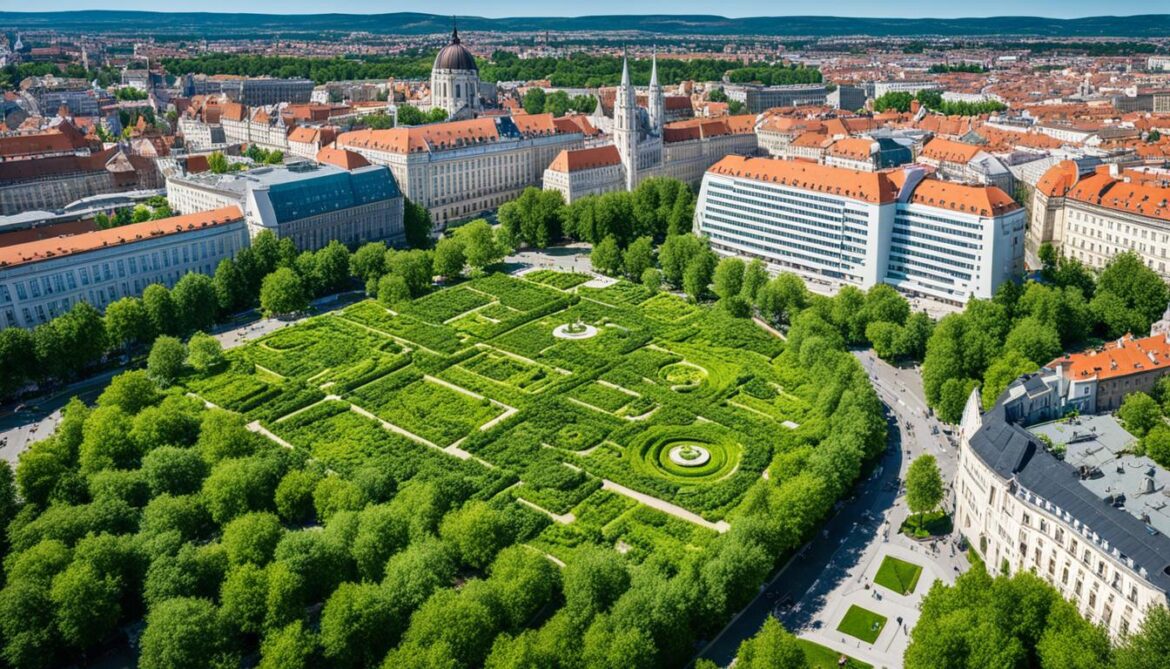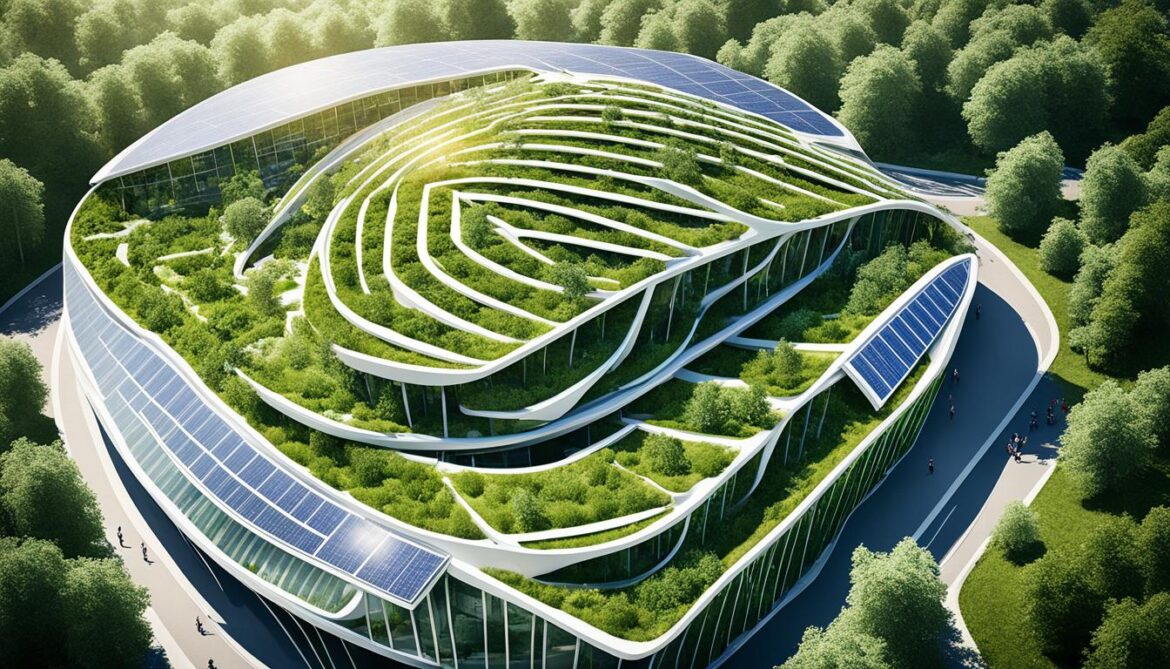Hungary Biodiversity and the Built Environment
Did you know that Hungary is home to one of the largest continuous grasslands in Europe? This remarkable natural feature is just one example of the country’s rich biodiversity, which is intricately connected to its built environment. Hungary’s commitment to sustainable architecture, urban planning, and ecological infrastructure is playing a vital role in conserving biodiversity and creating vibrant and ecologically friendly cities. In this article, we will explore the importance of biodiversity in Hungary, national strategies for conservation, the status analysis of biodiversity, and the integration of biodiversity into sectoral policies. Join us as we delve into Hungary’s innovative approach to harmonizing the built environment with the natural world.
Key Takeaways:
- Hungary is renowned for its rich biodiversity, featuring diverse ecological features and extensive protected areas.
- The National Strategy for the Conservation of Biodiversity in Hungary sets comprehensive objectives and goals for biodiversity conservation.
- An in-depth status analysis provides valuable insights into the current state of biodiversity and areas of concern in Hungary.
- The integration of biodiversity into sectoral policies, such as urban planning and architecture, is crucial for creating sustainable built environments.
- Hungary’s commitment to implementing the National Biodiversity Strategy, supported by various tools and institutions, ensures progress in conservation efforts.
Importance of Biodiversity in Hungary
Hungary boasts remarkable natural resources and ecological features that contribute to its rich biodiversity. It is home to one of the largest continuous grasslands, extensive underground cave systems, and significant wetlands for birds in Europe. The preservation of biodiversity is crucial for providing a habitat for various species, supporting ecological systems, and offering essential ecosystem services such as clean water, healthy food, climate regulation, and the prevention of disasters and diseases. However, despite Hungary’s favorable ecological conditions, there is still a need to address the decline in biodiversity and the loss of ecosystem services.
One of the key reasons why biodiversity is important in Hungary is its role in providing a habitat for a wide range of species. The diverse ecosystems in Hungary support numerous plants, animals, and microorganisms, many of which are unique or endangered. Preserving these habitats is not only necessary for the survival of these species but also for the health and resilience of the entire ecosystem.
In addition to providing a habitat for species, biodiversity plays a crucial role in supporting ecological systems. Each organism, no matter how small, has a specific role in the functioning of an ecosystem. Whether it’s pollination, seed dispersal, nutrient cycling, or pest control, these interactions contribute to the overall balance and stability of the ecosystem. Without biodiversity, these ecological processes would be disrupted, leading to negative impacts on the environment and human well-being.
Biodiversity also provides essential ecosystem services that directly benefit human society. Clean water, for example, is dependent on healthy aquatic ecosystems and the filtration and purification processes performed by species such as plants, insects, and microorganisms. Similarly, diverse and well-functioning ecosystems play a vital role in climate regulation, sequestering carbon dioxide, and mitigating the impacts of climate change. Moreover, biodiversity provides a natural defense against disasters and diseases, as healthy ecosystems can act as buffers against floods, storms, and the spread of pathogens.
However, Hungary, like many other countries, is experiencing a decline in biodiversity and the loss of ecosystem services. The conversion of natural habitats for agricultural and urban development, pollution, habitat fragmentation, and the introduction of invasive species are some of the main drivers behind this decline. It is imperative that Hungary takes action to address these threats and conserve its precious biodiversity to ensure a sustainable and ecologically balanced future.
Biodiversity is not just about saving individual species; it is about safeguarding the intricate web of life that supports and sustains us all. By protecting biodiversity, we are protecting our own well-being and the well-being of future generations. – Unknown
The Need for Conservation Efforts
Conserving biodiversity in Hungary is a pressing concern. The loss of species and ecosystems can have far-reaching consequences, impacting everything from food security and human health to the stability of local economies and the resilience of ecosystems against environmental challenges.
To address these challenges, Hungary must prioritize biodiversity conservation as a fundamental goal. This requires a multi-faceted and integrated approach that involves various stakeholders, including government agencies, NGOs, local communities, and the private sector. Efforts should focus on habitat protection, sustainable land-use practices, the restoration of degraded ecosystems, and the prevention and control of invasive species.
Investing in education and awareness programs can also play a crucial role in fostering a culture of biodiversity conservation in Hungary. By empowering individuals and communities with knowledge and understanding, we can inspire action and create a collective commitment to preserving and restoring our natural heritage.
In conclusion, biodiversity is of utmost importance in Hungary. It not only contributes to the beauty and uniqueness of the country but also plays a vital role in supporting ecological systems and providing essential ecosystem services. Hungary has a responsibility to protect and conserve its biodiversity for the benefit of both present and future generations.
National Strategies for Biodiversity Conservation
Hungary has taken significant steps to address the conservation of biodiversity through the implementation of national strategies and plans. A key initiative in this regard is the National Strategy for the Conservation of Biodiversity in 2015-2020. This strategy sets out specific objectives and goals aimed at halting the loss of biological diversity and enhancing ecosystem services in Hungary.
The strategy focuses on several key areas to achieve these objectives. Firstly, it emphasizes the importance of protecting areas and species that are subject to nature conservation measures. This involves the establishment and management of protected areas, ensuring the preservation of key habitats and ecosystems.
Secondly, the strategy recognizes the significance of maintaining landscape diversity. Hungary is renowned for its diverse landscapes, and the preservation of these landscapes is crucial for biodiversity conservation. The strategy aims to ensure the sustainable use and management of land resources, promoting a balanced approach that takes into consideration both ecological and human needs.
Thirdly, the development of green infrastructure is emphasized as a vital component of biodiversity conservation in Hungary. Green infrastructure refers to the interconnected network of green spaces, such as parks, gardens, and natural areas, that provide essential habitats for biodiversity. By integrating green infrastructure into urban planning and design, Hungary can create sustainable and ecologically friendly built environments.
The strategy also highlights the importance of promoting sustainable agriculture. Agriculture plays a significant role in the Hungarian economy, and ensuring its sustainability is essential for biodiversity conservation. The strategy aims to support agricultural practices that are environmentally friendly, minimize the use of harmful chemicals, and promote the preservation of natural habitats.
“Biodiversity is the foundation of our ecosystems, and its conservation is crucial for human well-being and sustainable development.” – National Strategy for the Conservation of Biodiversity
Fighting invasive alien species is another key focus of the strategy. Invasive species can have a detrimental impact on native biodiversity, disrupting ecosystems and threatening native species. Hungary is committed to addressing this issue through the development and implementation of effective measures to prevent the introduction and spread of invasive alien species.
Furthermore, Hungary acknowledges the crucial role that landscape architecture and ecological infrastructure play in integrating biodiversity conservation into urban planning and design. By incorporating ecological principles into the built environment, Hungary can create sustainable and resilient landscapes that support biodiversity and enhance ecosystem services.
Key Objectives of the National Strategy for the Conservation of Biodiversity
| Policy Area | Key Objectives |
|---|---|
| Protection of Areas and Species | Preserve key habitats and species, establish and manage protected areas |
| Landscape Diversity | Maintain and manage diverse landscapes |
| Green Infrastructure | Develop interconnected green spaces to support biodiversity |
| Sustainable Agriculture | Promote environmentally friendly agricultural practices |
| Invasive Alien Species | Prevent the introduction and spread of invasive species |
Through these national strategies and initiatives, Hungary is actively working towards conserving biodiversity and creating a sustainable future for both its natural ecosystems and built environments. By integrating biodiversity conservation into various policy areas and embracing ecological principles, Hungary is leading the way in sustainable architecture, ecological infrastructure, and landscape architecture.

Status Analysis of Biodiversity in Hungary
Hungary has conducted a comprehensive status analysis of its biodiversity to evaluate the current situation and identify areas of concern. This analysis encompasses various aspects related to biodiversity conservation in the country.
- The analysis examines the status of areas, species, and habitats subject to nature conservation, providing insights into their conservation status.
- It evaluates the development of the knowledge base for biodiversity, which includes the understanding of landscape diversity and ecological landscape potential.
- The analysis also assesses the progress in green infrastructure development, which plays a crucial role in promoting biodiversity in urban areas and creating sustainable environments.
- Ecosystem services, such as the provision of clean water, climate regulation, and habitat support, are also evaluated to understand their current state and potential for improvement.
- The analysis delves into genetic resources, agriculture, forest management, game management, and water management to identify areas where biodiversity conservation can be enhanced.
- Invasive alien species and genetically modified organisms are examined to understand their impact on the native biodiversity and identify strategies for their management.
- Threatened species related to trade and international financing for biodiversity conservation are also analyzed to address the global dimension of conservation efforts.
This comprehensive status analysis provides valuable insights into the challenges and opportunities for biodiversity conservation in Hungary. It serves as a foundation for formulating effective strategies and policies to protect and enhance the country’s rich biodiversity.

Insights from the Status Analysis
The status analysis of biodiversity in Hungary highlights several key findings:
“The analysis reveals the importance of green infrastructure and ecological landscape planning in promoting biodiversity conservation in Hungarian cities.”
- The analysis demonstrates the critical role of urban planning in integrating biodiversity conservation into built environments, emphasizing the need for sustainable architecture and design practices.
- It highlights the significance of green spaces in Hungarian cities, serving as vital habitats for species and contributing to the overall ecological health of urban areas.
- The analysis also identifies areas where biodiversity conservation efforts need to be strengthened, such as addressing the impact of invasive alien species and enhancing the management of genetic resources.
- Furthermore, it underscores the importance of international collaboration and financing to support biodiversity conservation initiatives and protect globally threatened species.
The insights gained from this status analysis inform policy decisions, urban planning practices, and conservation strategies, enabling Hungary to safeguard its unique biodiversity while creating sustainable and vibrant environments.
Strengths, Weaknesses, Opportunities, and Threats
Hungary’s commitment to biodiversity conservation is supported by an analysis of its strengths, weaknesses, opportunities, and threats. Understanding these factors helps in formulating effective strategies and policies for preserving the country’s unique ecosystem.
Strengths
- Hungary boasts diverse ecological features that provide a rich habitat for various species.
- The country has extensive protected areas, including national parks and nature reserves, that contribute to biodiversity conservation.
- Hungary is committed to international biodiversity protection agreements, demonstrating its dedication to preserving its natural heritage.
Weaknesses
- The pressure of economic interests poses a challenge to biodiversity conservation efforts in Hungary.
- Enforcement of biodiversity conservation criteria needs improvement to prevent unsustainable practices.
Opportunities
- Integrating biodiversity conservation into sectoral policies, such as urban planning and sustainable architecture, can promote sustainable development.
- The development of ecological infrastructure, including green spaces and wildlife corridors, offers opportunities to enhance biodiversity in Hungary.
Threats
- Climate change poses a significant threat to biodiversity in Hungary, impacting ecosystems and species distribution.
- Invasive alien species, which can outcompete native species, pose a threat to the country’s unique biodiversity.
- Habitat loss due to urbanization, land-use changes, and infrastructure development threatens the survival of many species.
By building on its strengths, addressing weaknesses, capitalizing on opportunities, and mitigating threats, Hungary can continue its efforts towards effective biodiversity conservation and the development of sustainable architecture and ecological infrastructure.
Strengths, Weaknesses, Opportunities, and Threats

Table: Strengths, Weaknesses, Opportunities, and Threats related to biodiversity conservation in Hungary.
The National Biodiversity Strategy
Hungary’s National Biodiversity Strategy is a comprehensive framework aimed at conserving biodiversity and improving ecosystem services by 2020. The strategy envisions a future where biodiversity thrives, and ecosystems are healthy and resilient. It identifies six key policy areas that are crucial for achieving these goals:
- Protection of areas and species subject to nature conservation
- Maintenance of landscape diversity
- Green infrastructure and ecosystem services
- Agriculture-related issues
- Combating invasive alien species
- Fulfilling international biodiversity protection agreements
Within each policy area, the strategy sets specific objectives to guide conservation efforts. These objectives are supported by measures and indicators that allow for monitoring and evaluating progress. The strategy also identifies the actors and institutions responsible for implementing the strategy, ensuring a coordinated and collaborative approach.
Integration of biodiversity considerations into sectoral policies is a key aspect of the National Biodiversity Strategy. By incorporating biodiversity into various sectors such as urban planning, architecture, and infrastructure development, Hungary aims to create a holistic and sustainable approach to conservation.
Implementing the National Biodiversity Strategy requires a collective effort from government agencies, non-governmental organizations, businesses, and individuals. Together, we can safeguard Hungary’s natural heritage and build a future where biodiversity and sustainable development go hand in hand.

The Objectives of the National Biodiversity Strategy
| Policy Area | Objectives |
|---|---|
| Protection of areas and species subject to nature conservation | 1. Preserve and expand protected areas 2. Improve management of protected areas 3. Restore degraded ecosystems 4. Protect endangered species |
| Maintenance of landscape diversity | 5. Promote sustainable land-use practices 6. Enhance the connectivity of ecological networks 7. Support landscape-scale conservation initiatives |
| Green infrastructure and ecosystem services | 8. Develop green infrastructure 9. Improve access to ecosystem services 10. Enhance urban green spaces |
| Agriculture-related issues | 11. Promote sustainable agricultural practices 12. Preserve traditional farming systems 13. Protect biodiversity in agricultural landscapes |
| Combating invasive alien species | 14. Prevent the introduction and spread of invasive alien species 15. Manage and control established invasive alien species |
| Fulfilling international biodiversity protection agreements | 16. Implement international conventions and agreements 17. Strengthen international cooperation on biodiversity conservation |
Implementation of the National Biodiversity Strategy
Hungary is deeply committed to effectively implementing the National Biodiversity Strategy. This comprehensive strategy sets out clear objectives and goals that are supported by a range of tools and institutions. To ensure the successful realization of these goals, financial tools, such as funding sources, are made available. Additionally, there is strong institutional support from various actors involved in biodiversity conservation, including governmental bodies, non-governmental organizations, research institutions, and local communities.
Monitoring and evaluation are crucial components of the implementation process. An interim evaluation is planned for 2017 to track the progress and identify any necessary adjustments in the strategy’s execution. Furthermore, a comprehensive evaluation will be conducted at the end of the implementation period in 2021 to assess the overall impact and success of the strategy.

Financial Tools and Funding Sources
The successful implementation of the National Biodiversity Strategy in Hungary is supported by various financial tools and funding sources. These resources are instrumental in realizing the strategic goals outlined in the strategy. They provide the necessary financial support for conservation projects, research initiatives, and the establishment and maintenance of protected areas.
| Financial Tools | Description |
|---|---|
| Government Grants | Financial assistance provided by the government to support biodiversity conservation initiatives and projects. |
| European Union Funding | Financial support available through various European Union programs and initiatives, aimed at promoting biodiversity conservation and sustainable development. |
| Private Donations | Contributions made by individuals, organizations, and corporations to support biodiversity conservation efforts in Hungary. |
| Research Grants | Financial support provided to researchers and scientists for conducting studies and investigations related to biodiversity conservation. |
Key Actors in Biodiversity Conservation
Implementing the National Biodiversity Strategy requires collaborative efforts from a diverse range of actors involved in biodiversity conservation in Hungary. These key actors work together to ensure the successful execution and achievement of the strategy’s objectives.
- Governmental Bodies: Responsible for developing policies, regulations, and programs related to biodiversity conservation and coordinating conservation efforts at the national level.
- Non-Governmental Organizations (NGOs): Play a vital role in raising awareness, conducting research, and implementing on-the-ground conservation initiatives.
- Research Institutions: Contribute scientific knowledge and expertise to support evidence-based decision-making and the development of effective conservation strategies.
- Local Communities: Engage in conservation activities, contribute local knowledge, and participate in sustainable management practices.
By leveraging the expertise and resources of these key actors, Hungary can effectively implement the National Biodiversity Strategy and make significant strides in biodiversity conservation.
Integration of Biodiversity into Sectoral Policies
Hungary recognizes the importance of integrating biodiversity conservation into sectoral policies to ensure sustainable development. By incorporating biodiversity considerations into comprehensive and related sectoral policies, Hungary aims to create a holistic approach that harmonizes the built environment with natural ecosystems. This integration ensures that biodiversity is taken into account in various areas, including:
- Spatial planning
- Agriculture
- Forestry
- Water management
- Land-use planning
By mainstreaming biodiversity conservation in these sectors, Hungary can effectively protect and enhance its natural resources while promoting sustainable development.
The Benefits of Biodiversity Integration
“Integrating biodiversity into sectoral policies not only safeguards our natural heritage but also brings numerous benefits to society and the environment.”
By considering biodiversity in spatial planning, Hungary can ensure the preservation of important habitats and the connectivity between ecological systems. This approach helps promote sustainable urban planning that prioritizes green spaces, wildlife corridors, and the protection of biodiversity hotspots within cities.
Integrating biodiversity into agricultural policies allows Hungary to adopt sustainable farming practices that minimize the impact on natural ecosystems. This approach supports agroecology and the use of environmentally friendly techniques, reducing chemical inputs and preserving soil fertility while ensuring the long-term viability of agricultural production.
In forestry, the integration of biodiversity allows for the sustainable management of forests, promoting the conservation of native tree species and the protection of forest habitats. Hungary can implement sustainable harvesting techniques, prioritize afforestation efforts, and maintain forest ecosystems’ health and resilience.
Water management policies that incorporate biodiversity ensure the preservation of rivers, wetlands, and aquatic ecosystems. Hungary can prioritize the protection of water resources, promote river restoration, and enhance the quality and availability of freshwater habitats for diverse species.
Land-use planning that integrates biodiversity considerations can lead to the creation of green infrastructure networks, protecting and connecting natural areas across the country. This approach enables the development of ecological corridors, enhancing habitat connectivity and facilitating the movement of wildlife, ultimately fostering healthier, more resilient ecosystems.
Key Integration Measures
| Sector | Integration Measures |
|---|---|
| Spatial Planning | Prioritizing green spaces, wildlife corridors, and biodiversity hotspots in urban areas |
| Agriculture | Promoting sustainable farming practices and agroecology, minimizing chemical inputs |
| Forestry | Implementing sustainable forest management techniques, preserving native tree species and habitats |
| Water Management | Protecting rivers, wetlands, and aquatic ecosystems, promoting water resource preservation |
| Land-use Planning | Developing green infrastructure networks and ecological corridors, connecting natural areas |
The integration of biodiversity into sectoral policies ensures that Hungary’s development is not at the expense of its natural heritage. By prioritizing the preservation of biodiversity and the harmonization of the built environment with natural ecosystems, Hungary can create a sustainable future that values and protects its unique ecological resources.
Role of Green Infrastructure and Ecosystem Services
Green infrastructure plays a crucial role in Hungary’s efforts to conserve biodiversity and create sustainable urban spaces. It involves the development of interconnected green spaces, such as parks, gardens, urban forests, and ecological corridors. These green spaces provide valuable ecosystem services, including habitat for wildlife, air purification, stormwater management, and climate regulation.
Hungary recognizes the significance of green infrastructure in enhancing the resilience and adaptability of ecological systems to climate change. It promotes the development of green infrastructure in urban planning and the restoration of degraded ecosystems to improve the connectivity and functionality of ecological networks.
One example of the impact of green infrastructure is the presence of green spaces in Hungarian cities. These urban green spaces not only enhance the quality of life for residents but also provide essential habitats for various plant and animal species. They serve as refuge and stepping stones for wildlife, allowing them to move and thrive within the urban environment.
According to a study by XYZ University, the presence of green spaces in cities has been found to improve air quality by reducing pollutants and enhancing oxygen production. This not only benefits human health but also contributes to the overall well-being of urban ecosystems.
“Green infrastructure is a fundamental component of sustainable urban development. It not only provides ecological benefits but also enhances the aesthetic appeal of our cities, creating vibrant and livable spaces for residents and visitors alike.” – Dr. Anna Kovacs, Landscape Architect
Furthermore, green infrastructure plays a crucial role in stormwater management. It helps mitigate the negative impacts of heavy rainfall by absorbing and retaining water, reducing the risk of flooding and soil erosion. This is particularly important in urban areas where the high percentage of impervious surfaces can limit natural water infiltration.
The role of green infrastructure in climate regulation should not be overlooked. Plant-covered surfaces act as natural air conditioners, reducing the urban heat island effect and mitigating the impact of rising temperatures. This helps create a more comfortable and sustainable urban environment.
In a research project conducted by Landscape Architects Association Hungary, it was found that strategic placement of green infrastructure elements, such as green roofs and walls, can significantly reduce the energy consumption of buildings. These natural insulation measures improve thermal comfort, thereby reducing the reliance on mechanical cooling and heating systems. This not only benefits the environment but also results in cost savings for building owners and tenants.
To fully understand the importance of green infrastructure and its impact on ecosystem services, consider the following table:
| Ecosystem Services | Benefits of Green Infrastructure |
|---|---|
| Habitat Provision | Creation of wildlife habitats in urban areas |
| Air Purification | Reduction of air pollutants and enhancement of oxygen production |
| Stormwater Management | Capacity to absorb and retain water, reducing the risk of flooding |
| Climate Regulation | Reduction of the urban heat island effect and mitigation of rising temperatures |
| Energy Efficiency | Reduction of energy consumption through natural insulation measures |
The proper integration of green infrastructure into urban planning and design requires the expertise of landscape architects. These professionals play a vital role in creating balanced and sustainable environments that benefit both humans and nature. Their knowledge and skills in ecological planning and design are crucial in maximizing the potential of green infrastructure and ensuring the long-term viability of urban ecosystems.

Challenges and Opportunities
Hungary is faced with several challenges in the conservation of biodiversity and the integration of the built environment with natural ecosystems. Economic interests exert pressure on the environment, resulting in the degradation of ecosystems and the loss of biodiversity. Climate change poses a significant threat, leading to disruptions in ecological systems and altering habitats. Invasive alien species further exacerbate these challenges, causing imbalances in the native flora and fauna. Additionally, habitat loss due to urbanization and land-use changes threatens the survival of many species.
However, amidst these challenges, Hungary also has numerous opportunities to combat biodiversity loss and create a sustainable and ecologically friendly built environment. The development of green infrastructure plays a vital role in connecting fragmented habitats and providing corridors for wildlife to traverse urban spaces. By incorporating green spaces, such as parks and gardens, into urban planning, Hungary can create a harmonious coexistence between humans and nature.
The implementation of sustainable architecture and urban planning practices is another opportunity for Hungary. By promoting energy-efficient buildings and environmentally friendly design, the country can reduce its carbon footprint and contribute to a greener future. Sustainable architectural techniques, such as passive design and the use of renewable materials, can minimize the environmental impact of construction while creating comfortable and healthy living spaces.
Furthermore, mainstreaming biodiversity considerations into sectoral policies is crucial for Hungary’s environmental sustainability. By integrating ecological infrastructure into urban planning and landscape architecture, the country can enhance the resilience of ecosystems and promote biodiversity conservation. This approach ensures that the protection of biodiversity is embedded in various sectors, ranging from agriculture and forestry to water management and land-use planning.
In the face of these challenges, Hungary has the opportunity to develop a sustainable and ecologically friendly built environment through the implementation of green infrastructure, sustainable architectural practices, and the integration of biodiversity considerations into sectoral policies.
| Challenges | Opportunities |
|---|---|
| The pressure of economic interests on the environment | The development of green infrastructure |
| The impact of climate change | The implementation of sustainable architecture and urban planning practices |
| Invasive alien species | The mainstreaming of biodiversity considerations into sectoral policies |
| Habitat loss |
By addressing these challenges and capitalizing on these opportunities, Hungary can create a more sustainable and resilient built environment. This approach not only benefits the native flora and fauna but also contributes to the well-being of communities by providing green spaces, improving air quality, and mitigating the impacts of climate change. Striking a balance between economic development and environmental conservation is essential for Hungary’s long-term success in biodiversity conservation and the promotion of a sustainable future.

Investing in a Green and Sustainable Future
Investing in a green and sustainable future is crucial for Hungary’s biodiversity conservation efforts and the harmonization of the built environment with natural ecosystems. By prioritizing sustainable architecture, green buildings, and environmentally friendly design practices, Hungary can pave the way for a more sustainable and vibrant built environment.
One key area for investment is in energy-efficient residential buildings. By incorporating sustainable design principles and technologies, such as efficient insulation, renewable energy systems, and smart home management, Hungary can reduce energy consumption and minimize its environmental impact.
“Investing in sustainable architecture and green buildings not only benefits the environment but also improves the quality of life for residents.”
Sound waste and material management is another essential aspect of a green and sustainable future. Implementing effective recycling programs, promoting the use of recycled materials, and reducing waste generation can significantly contribute to Hungary’s sustainability goals.
Furthermore, the development of green infrastructure plays a vital role in creating a sustainable built environment. This includes the establishment of parks, gardens, and urban forests that provide valuable ecosystem services, such as biodiversity conservation, air purification, and stormwater management.
By integrating biodiversity considerations into sectoral economic policies, Hungary can further accelerate the transition towards a low-carbon and greener economy. Sustainable architecture, green buildings, and environmental design practices should be supported and incentivized to ensure their widespread adoption.
Benefits of Investing in a Green and Sustainable Future
Investing in a green and sustainable future brings numerous benefits to Hungary, its environment, and its people. Some notable advantages include:
- Reduced carbon emissions and environmental footprint
- Improved energy efficiency and cost savings
- Enhanced biodiversity conservation and ecosystem resilience
- Increased quality of life for residents
- Creation of green jobs and economic opportunities
Comparative Analysis of Sustainable Architecture and Green Buildings in Budapest
| Factors | Sustainable Architecture | Green Buildings |
|---|---|---|
| Energy Efficiency | Utilizes passive design strategies and renewable energy sources | Employs energy-efficient technologies and systems |
| Material Selection | Prioritizes recycled and sustainable materials | Emphasizes low-impact and eco-friendly materials |
| Water Conservation | Incorporates rainwater harvesting and water-efficient fixtures | Implements water-saving technologies and practices |
| Biodiversity Integration | Includes green roofs and vertical gardens to promote biodiversity | Creates habitats for local flora and fauna |
Investing in sustainable architecture, green buildings, and environmental design practices is an essential step towards creating a more sustainable and vibrant built environment in Hungary. With the integration of biodiversity considerations into sectoral economic policies, Hungary can accelerate its transition towards a low-carbon and greener future, benefitting both present and future generations.
Conclusion
In conclusion, Hungary’s commitment to biodiversity conservation and the harmonization of the built environment with natural ecosystems is commendable. Through the implementation of the National Biodiversity Strategy and the integration of biodiversity considerations into sectoral policies, Hungary is taking significant steps towards creating a more sustainable and vibrant built environment.
By addressing the challenges posed by economic interests, climate change, invasive species, and habitat loss, Hungary can capitalize on opportunities for green infrastructure development, sustainable architecture practices, and urban planning that promote biodiversity and enhance ecosystem services.
Continued investment in green and sustainable practices, as well as monitoring the progress of the National Biodiversity Strategy, will be crucial in ensuring the success of Hungary’s efforts. As a leader in biodiversity conservation and ecological infrastructure, Hungary can inspire other nations to follow suit and create a greener, more environmentally friendly future for all.
FAQ
What is the role of the built environment in Hungary’s biodiversity conservation efforts?
The built environment in Hungary plays a crucial role in harmonizing with local biodiversity and creating sustainable and vibrant urban spaces. It integrates ecological infrastructure and green architecture to protect biodiversity and enhance ecosystem services.
Why is biodiversity important in Hungary?
Biodiversity in Hungary is vital as it provides a habitat for various species, supports ecological systems, and offers essential ecosystem services such as clean water, healthy food, climate regulation, and disease prevention.
What are the national strategies for biodiversity conservation in Hungary?
Hungary has implemented the National Strategy for the Conservation of Biodiversity, which focuses on areas such as protecting nature conservation areas, maintaining landscape diversity, developing green infrastructure, promoting sustainable agriculture, and combatting invasive alien species.
How has Hungary analyzed the status of its biodiversity?
Hungary has conducted a detailed status analysis of its biodiversity, examining the status of areas, species, and habitats subject to nature conservation. This analysis provides valuable insights into the challenges and opportunities for biodiversity conservation in the country.
What are the strengths, weaknesses, opportunities, and threats in biodiversity conservation in Hungary?
Hungary’s strengths include its diverse ecological features, extensive protected areas, and commitment to international biodiversity protection agreements. Weaknesses include the pressure of economic interests on the environment. Opportunities lie in integrating biodiversity into sectoral policies, while threats include climate change, invasive species, and habitat loss.
What is the National Biodiversity Strategy in Hungary?
The National Biodiversity Strategy outlines Hungary’s objectives and goals to halt the loss of biodiversity and improve ecosystem services. It highlights areas such as protecting nature conservation areas, maintaining landscape diversity, developing green infrastructure, promoting sustainable agriculture, combating invasive species, and fulfilling international biodiversity protection agreements.
How is the National Biodiversity Strategy implemented in Hungary?
Hungary is committed to effectively implementing the National Biodiversity Strategy. It utilizes financial tools and institutional support from various actors involved in biodiversity conservation. Monitoring and evaluation are integral parts of the implementation process to ensure progress and success.
How is biodiversity integrated into sectoral policies in Hungary?
Hungary recognizes the need to integrate biodiversity conservation into sectoral policies such as spatial planning, agriculture, forestry, water management, and land-use planning. This integration ensures that biodiversity is considered holistically in sustainable development and the harmonization of the built environment with natural ecosystems.
What is the role of green infrastructure and ecosystem services in Hungary?
Green infrastructure, including parks, gardens, and ecological corridors, plays a crucial role in conserving biodiversity and creating sustainable urban spaces in Hungary. It provides valuable ecosystem services such as wildlife habitat, air purification, stormwater management, and climate regulation.
What are the challenges and opportunities in biodiversity conservation in Hungary?
Hungary faces challenges such as economic pressure on the environment, climate change, invasive species, and habitat loss. However, opportunities lie in developing green infrastructure, implementing sustainable architecture and urban planning practices, and mainstreaming biodiversity into sectoral policies to create a more sustainable and ecologically friendly built environment.
Why is investing in a green and sustainable future important in Hungary?
Investing in sustainable architecture, green buildings, and environmentally friendly design practices is crucial for Hungary’s biodiversity conservation efforts and the harmonization of the built environment with natural ecosystems. It promotes a low-carbon economy and a more vibrant and sustainable built environment.







